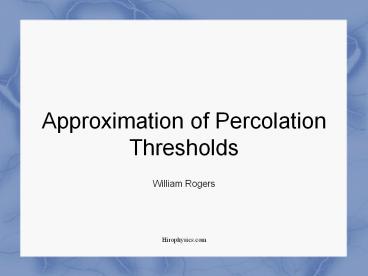Approximation of Percolation Thresholds PowerPoint PPT Presentation
1 / 15
Title: Approximation of Percolation Thresholds
1
Approximation of Percolation Thresholds William
Rogers
2
What is Percolation Theory?
- Theory that deals with fluid flow (or a similar
process) through a randomly arranged media - Developed to mathematically deal with disordered
media
3
What is Percolation Theory?
- Deals with sites of arbitrary dimensions which
consist of randomly placed and interconnected sub
units - The theory is concerned with the existence of a
percolation threshold - States that there is a minimum threshold where a
path can be found from one end to another
4
Why Study Percolation Theory?
- Can be used to assist in prediction of
- Propagation of fires through a forest
- The distribution of gas inside porous rocks and
reservoirs - Electrical resistance in a mixture of two
materials
5
- Problems
- Probabilistic Model
- More accuracy More trials
- Experiments can be computationally expensive
- Early tests required gt36 hours of continuous
processing time
- Solutions
- Develop a means of threshold approximation
- This experiment was developed to determine if
small trials with small sites could be used to
approximate the threshold of larger sites
6
Simulations
- Two batches
- 1,000,000 trial to determine thresholds
- 1,000 to approximate
- Square Sites
- Site Sizes 5x5, 25x25, 50x50, 100x100
- Rectangular Sites
- Two ratios 2x1 and 1x2
- 1x2 Site Sizes 5x10, 25x50, 50x100, 100x200
- 2x1 Site Sizes 10x5, 50x25, 100x50, 200x100
7
Testing Method
1. For each designated bin, make certain amount
of trials. (1,000,000 and 1,000 are used.)
2. Calculate the probability of the successful
connection for each bin.
3. Plot the all of the probabilities for each bin.
8
Results
9
Results
10
Results
11
Results
12
Results
13
Results
14
Conclusions
- Behavior of square sites was accurately
approximated by all square site sizes tested - Behavior of rectangular sites varied by size too
much for a one size fits all approximation - However, small trials approximated the behavior
of large trials for the same sized rectangular
sites - Efficient approximation
- Small trial time, in most cases, was 0.1 of the
large trial time - One exceptional case 5x5 0.003
15
Further Research Possibilities
- Refinement of results Attempt better accuracy
- Further development of approximation techniques
- Further testing of rectangular sites
- Other site shapes, node shapes and node patterns

